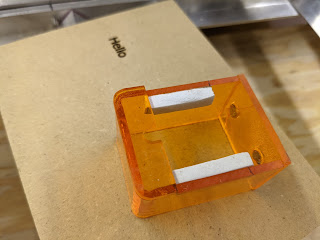Build Notes #1
MoBeam is intended to be a shop tool like a router or jigsaw. To that end, I focused on its mobility with the ability to engrave on finished woodworks of various types and sizes including vessels turned on my wood lathe. I traded off automation for simplicity and at the expense of more manual adjustments.
A fundamental concept was to leave the laser diode module at a fixed focus and instead move the entire assembly and/or a focal plane insert up-down as needed to get the target in focus. Sound crazy?
The laser focus is set at 30mm [G8 lens] up from the bottom surface of the base frame. The entire assy or alternately just the focal frame is then adjusted up/down based on the thickness of the target. In a way setting up MoBeam is similar to setting the bit depth on a wood router.
The laser module gantry assembly is mounted on a piece of 3/4" plywood into which an opening is cut. This opening is left open or alternately accommodates a honeycomb bed [the one I bought for my K40 and never used]. The entire assemblies surface is adjustable with 4 1/4-20 bolts
Very thick or odd shaped targets:
When left open the target is placed on the bench under MObeam and the entire assy is adjusted up/down with 4 legs until the target is parallel to the bottom of the base plate.
Small Flat Targets That Fit on the Cutting Bed [in the focal frame]
When the focal frame is used it is mounted in the opening and 4 screws allow it to be adjusted until the target’s [laying on the bed] surface is the correct distance from the laser's lens. The assy is mounted into the base plate with 4 thumbscrews. Focus adjustments are made with a gauge block.
Large Flat Work
If a larger flat material needs to be engraved [front of a chest] the gantry assy can be dismounted from the base frame by removing 4 [thumb] screws from the side plates.
The gantry assy is placed flat on top of the target and no additional adjustment is needed.
Laser Module AdjustmentsThe only time the laser module needs adjusting is if the lens is changed and then it is simply located to the surface with a gauge block.
Cheap n Dirty Build Highlights
Views showing the adjustments for the base frame and focal frame insert.
Detailed views of the focal plane adjustment mechanism.
Yes I know, I cringed when I started this design …
However this assy worked better than I expected. Then again I took a lot of care to ensure the holding bracket and the bed mounts were perfectly aligned. The adjustments [one screw at a time] were not as clunky and painstaking as I thought and it did not bind until I adjusted only one screw a ridiculous amount relative to the others.
Known problems:
The nutserts in the lift bracket don’t like the thin AL angle and tend to come loose, a PEM nut would be better.
The honeycomb bed is not really flat [never realized that] a thin perforated metal plate would be better.
Known Improvements/Adds & Before You Ask
- Tilt and lift interlocks on laser power
- Air evacuation. I am working on a plenum that slides under the baseframe.
- Filter: considering a canister filter design that uses the evac fan salvaged from my HVAC replacement
- Completed: Thumbscrews and cap head on adjustment screws to prevent striping and the need for hand tools.
- Protective cover and handle for storage.
- The use of metal vs wood for the base plate would help with fastening and dimensional predictability but beam reflections would need to be considered.
- Taller Acrylic side plates for better stability.
Enjoy and please comment,
Don

















